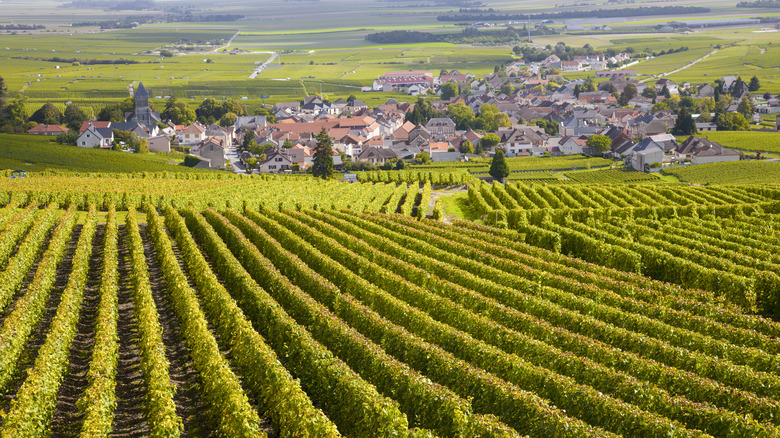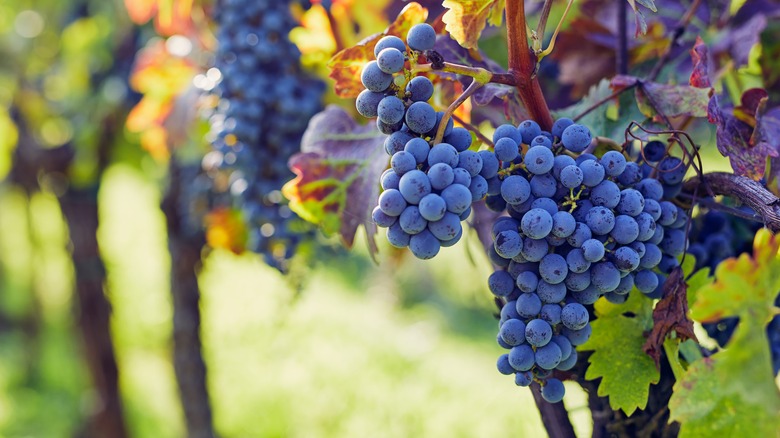The Country That Produces The Most Wine
The country that makes the most wine and the country that drinks the most wine isn't the same, but that's very nearly the case. France, the ancestral home of many of the world's best wines, was the top wine-producing nation in 2023, at least according to the preliminary figures reported by the International Organisation of Vine and Wine (OIV). France bested Italy, which had been the foremost producer in 2022, per Statista. France is also second in the world in wine consumption, trailing only the U.S. in that regard.
Each country's consumers will have less to drink in 2024, however, as 2023 proved to be a rather disastrous harvest for many of the world's other wine-producing nations. In fact, the OIV also observed that the most recent harvest was the worst, production-wise, since 1961. The poor results were attributed to the effects of climate change. France, for example, was able to regain the top spot due to poor wine harvests in Italy and Spain, and in both instances, weather-related issues were the cause of significant drops in production.
But it was in the Southern Hemisphere (South America, most notably) where weather conditions most impacted wine production, leading to precipitous drops. The news wasn't all bad elsewhere, though. A few nations, including the U.S., benefited from good weather and were able to meet or exceed expected production totals.
How climate change impacted worldwide wine production
What were the weather conditions that led to such poor wine harvests, not only across the Southern Hemisphere but in parts of Europe? Everything from severe drought to flooding, per the OIV. Early frost and other extremes (like wildfires and punishing hailstones) also impacted harvests in some countries.
Italy and Spain finished second and third in the world in wine production in 2023 despite notably poor conditions, the OIV noted when issuing its recent projections. Italy weathered heavy rainfall, for example, which resulted in a 12% drop in Italian wine production overall relative to 2022. In Spain, meanwhile, drought conditions accounted for its 14% year-to-year production decrease.
Some South American nations were even more adversely impacted. Brazil saw its wine harvest numbers drop by 30% while Argentina's fell by 23%, and Chile's by 20%. The latter was beset by both drought and wildfires but still managed to finish as the world's fifth-largest wine producer for the year, just ahead of Australia. South America's misfortune was not mirrored in North America where the U.S., the world's fourth largest wine producer, saw a 12% uptick in production during this year's wine harvest. However, the OIV has yet to issue its final figures, pending harvest results in China.
Wine grapes weren't the only agricultural product notably affected by climate change in 2023. It was also a rough year for crops like blueberries, olives, rice, and potatoes, Forbes reported, due to historically high temperatures across the globe.
Different countries lead the way in red, white, and rosé wine production
France may have topped the list in terms of overall wine production in 2023, but it's not the country that's been making the most red wine in recent years. According to a study by the OIV that looked at production and consumption over three different periods (2014 to 2021 being the most recent), Italy still tops overall in this category, producing 17.3% of the world's red wine. This percentage was buoyed by the country's abundant plantings of Sangiovese, its leading red wine grape. France and Spain, meanwhile, were not far behind Italy over the seven years, accounting for 13.9% and 13.5% of all red wine, respectively.
Italy was also the top white wine producer in the OIV study, outpacing its European competitors in this category, too. Glera, the grape responsible for Italy's Prosecco sparkling wines, contributed to Italy's 21.1% market share of the world's white wine production. France was second, producing 15.4%, Spain third with 14.2%.
France still dominates, however, in the production of rosé, accounting for 31.9% of the world's rosé wines from 2014 to 2021. Spain and the U.S. were the next closest producers, turning out 18.6% and 16.5% of these traditional summertime sippers, respectively, per the OIV. Which country's citizens have been drinking the most wines in these categories over the past seven years? China consumes the most red while the U.S. leads the way for white, and France for rosé.



